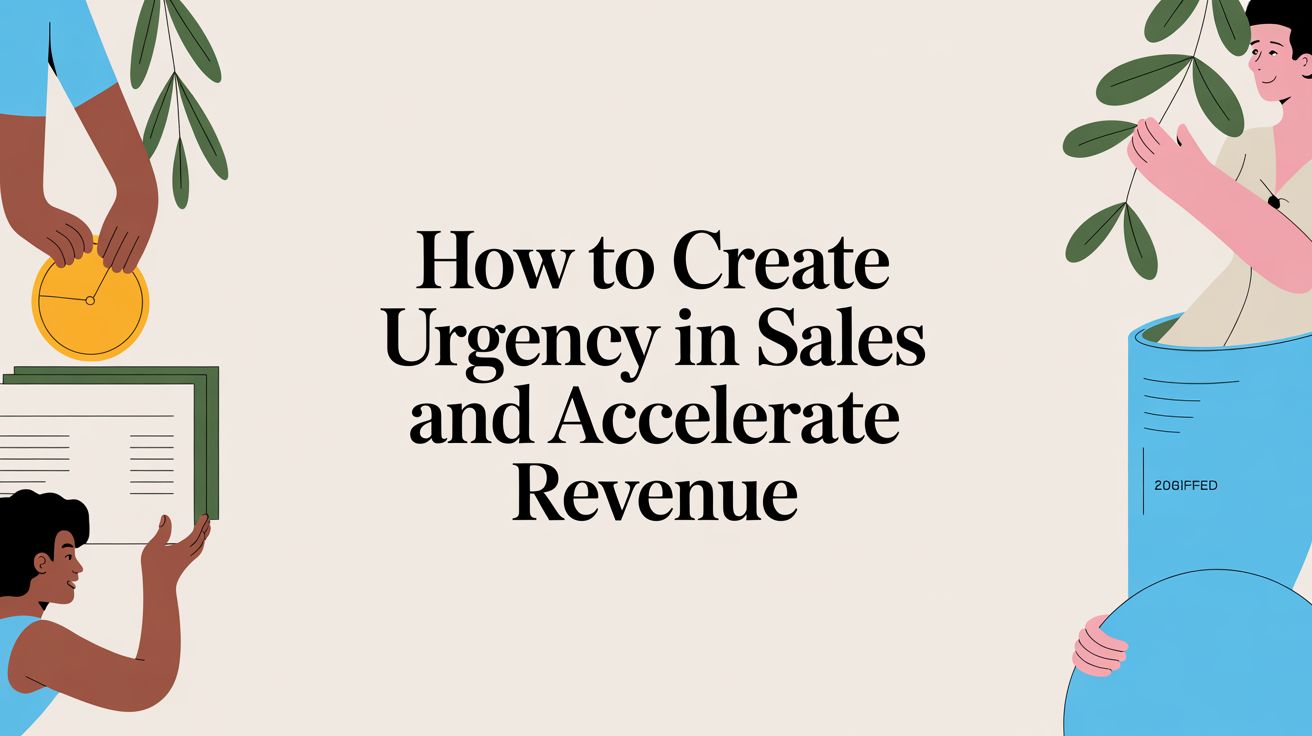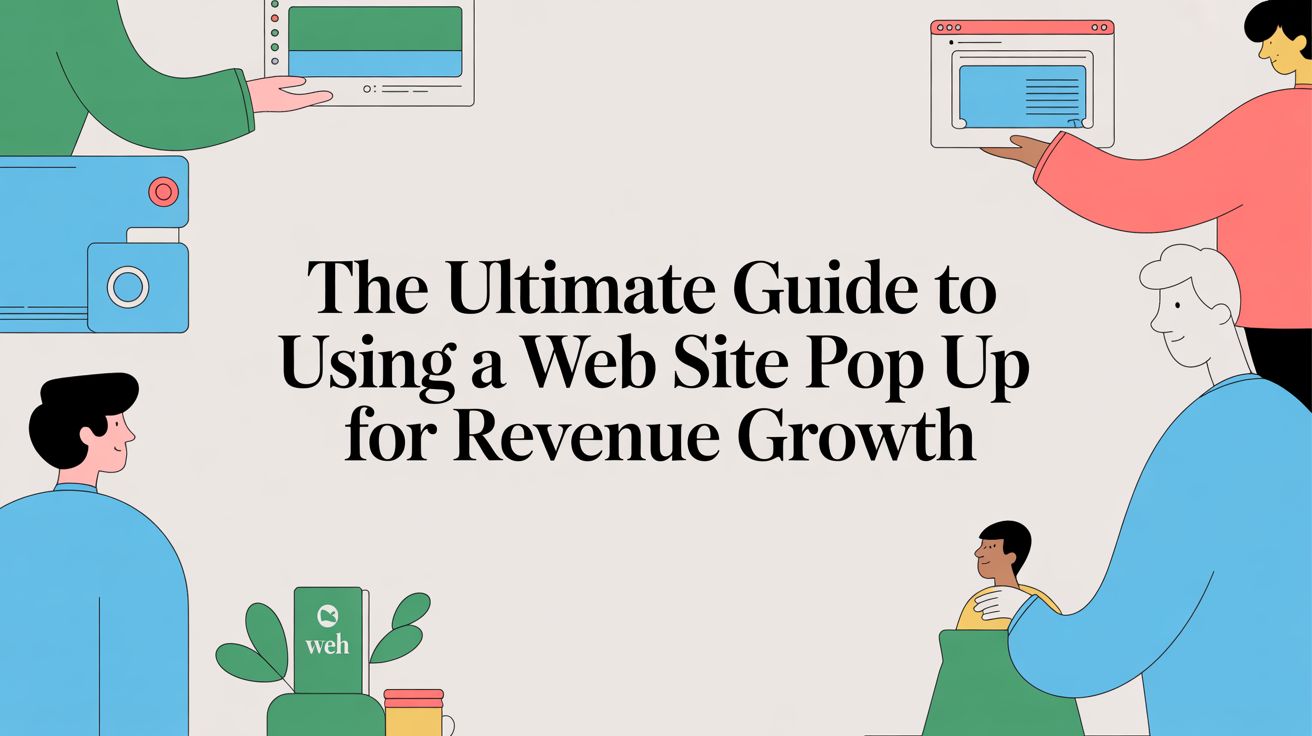
Top Apps for Shopify Store to Boost Sales & Efficiency
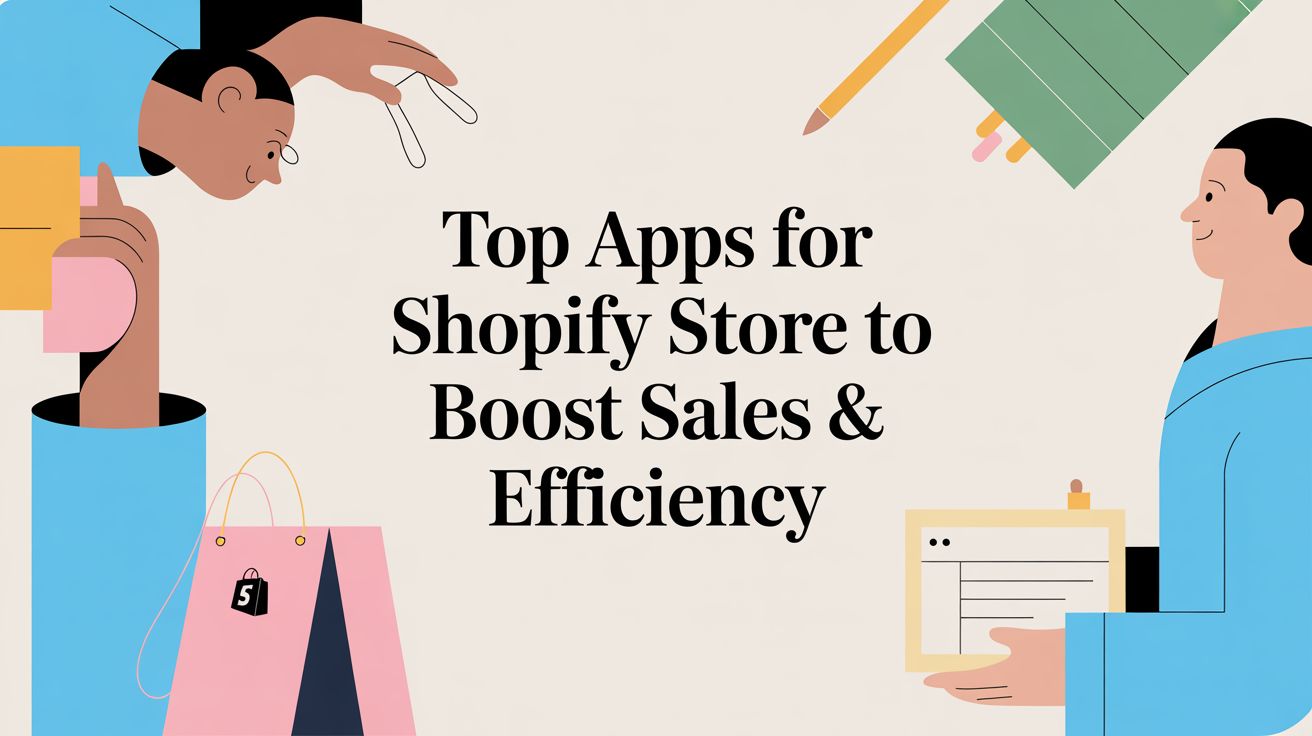
Trying to run a Shopify store without the right apps is like building a house with only a hammer. You have the foundation, but you're missing the specialized tools that make the job faster, better, and more efficient. The best apps for a Shopify store aren't just fancy add-ons; they're strategic investments that can turn a basic storefront into a powerful, automated sales engine.
Why Your Store Needs the Right Shopify App Strategy
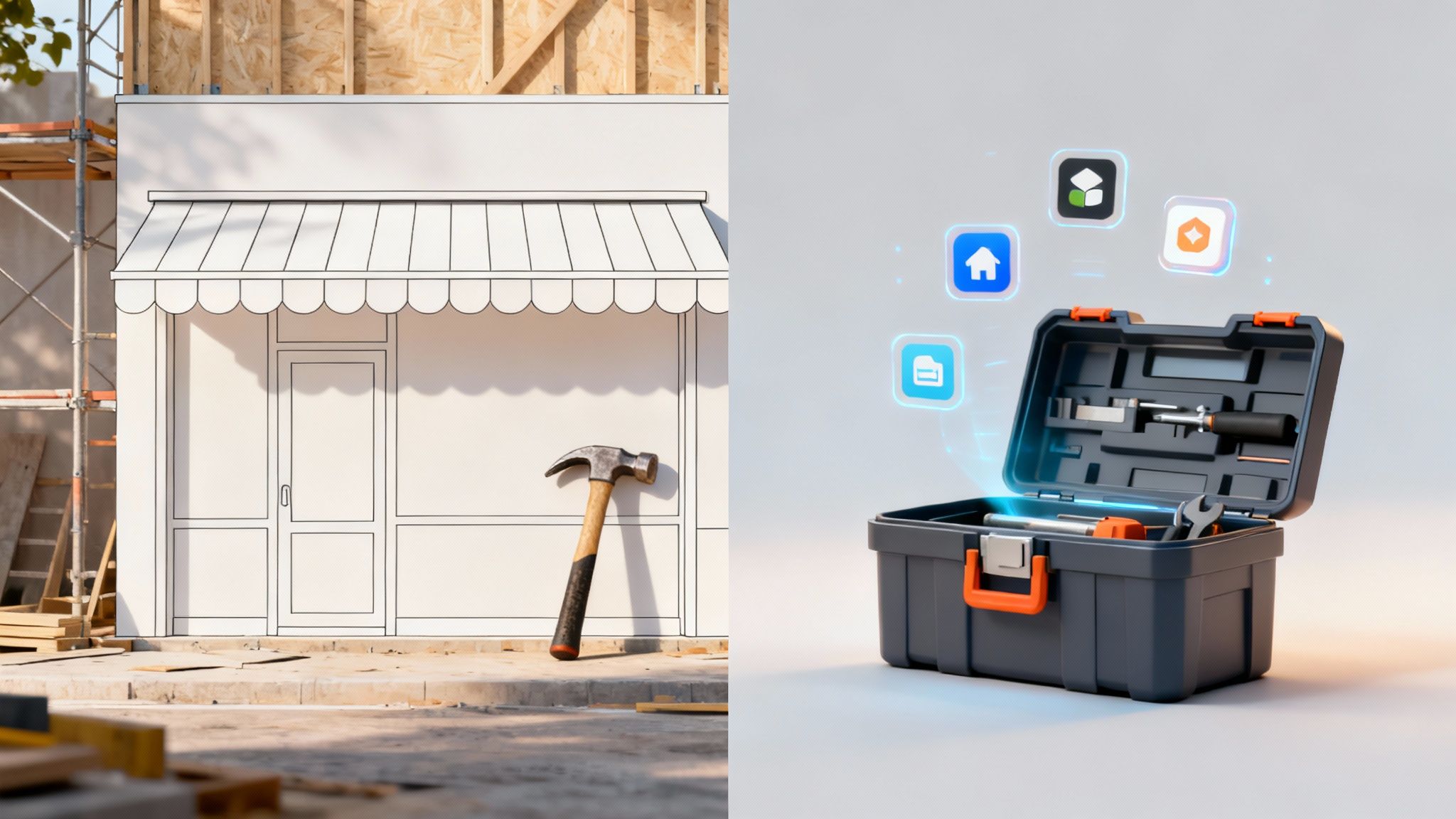
It’s easy to fall into the trap of seeing apps as just features. But a carefully chosen "app stack" is a non-negotiable part of scaling an e-commerce business. Each app you install should be a direct solution to a specific operational headache, whether that's recovering the 70% of carts that are typically abandoned—an industry benchmark from consumer psychology studies—or untangling complex inventory and shipping logistics.
Think of the Shopify App Store as your personal toolkit. You wouldn't just grab random tools hoping for the best. A pro selects the exact instrument for the job at hand. This mindset shifts your thinking from, "What does this app do?" to "What business problem does this app solve for me?"
The Business Impact of a Curated App Stack
The right collection of apps delivers real, measurable results that go way beyond vanity metrics. They’re absolutely fundamental to protecting your profit margins and giving you back your time.
For instance, an advanced returns management app can slash processing costs, while a smart marketing automation tool can boost customer lifetime value—all without adding hours to your workday. This strategic approach is exactly how top-performing brands grow so effectively.
The vast majority of merchants are already on board. In fact, around 87% of Shopify store owners use apps to add critical functionality to their stores. The average store owner installs about six apps to fine-tune their operations and create a better customer experience. You can find more insights on Shopify app usage and its impact on store performance.
Below is a quick look at how specific app categories line up with common business challenges, showing you exactly where they can make a difference.
How Shopify Apps Address Core Business Needs
| Business Challenge | App Category Solution | Primary Business Impact |
|---|---|---|
| High cart abandonment rates | Cart Recovery & Urgency Marketing | Increased revenue and conversion rates |
| Low customer lifetime value | Loyalty & Rewards Programs | Improved customer retention and repeat purchases |
| Inefficient shipping & returns | Fulfillment & Logistics Management | Reduced operational costs and happier customers |
| Difficulty acquiring new customers | SEO & Advertising Tools | Higher traffic and better brand visibility |
| Poor on-site conversion | Page Builders & CRO Tools | Enhanced user experience and higher sales |
| Lack of social proof | Product Reviews & UGC | Increased trust and conversion rates |
As you can see, there's a direct line from a business pain point to a specific app solution. It's all about matching the right tool to the right problem to get the outcome you want.
A well-chosen app stack isn't an expense; it's a high-return investment. The goal is to build an ecosystem where each app contributes directly to revenue growth, operational efficiency, or an improved customer journey, ensuring every dollar spent delivers a clear ROI.
Navigating the Shopify App Ecosystem
Stepping into the Shopify App Store can feel like visiting a massive city for the first time—it's exciting, but the sheer scale can be a lot to take in. The number of choices presents both a huge opportunity and a real challenge.
But it’s best to view this landscape not as a chaotic bazaar, but as a carefully curated, constantly evolving library of business tools. The rapid growth is really driven by two things: relentless innovation from developers and Shopify's own tough quality standards. This setup ensures that powerful, specialized, and reliable apps for a Shopify store are always hitting the market.
Instead of feeling overwhelmed, understanding this structure gives you the power to find the exact tools built for your specific business needs.
This infographic breaks down that journey, showing how you go from a massive marketplace to finding a high-impact solution for your store.
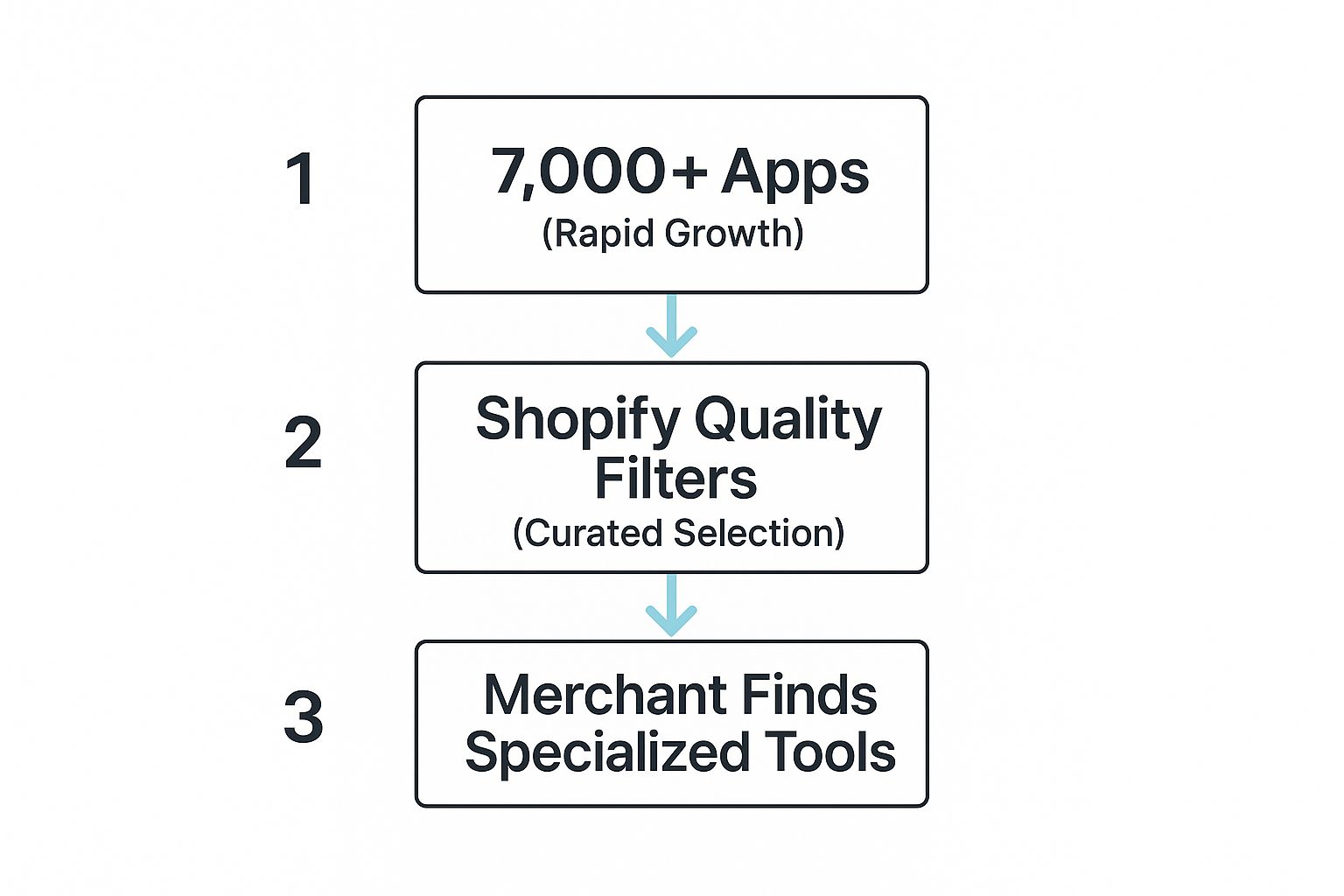
This flow really highlights how Shopify’s ecosystem filters endless options into a manageable set of quality, relevant tools just for merchants like you.
The Scale of Opportunity
The growth has been nothing short of explosive. As of January 2025, the Shopify App Store is home to roughly 12,320 apps.
To put that in perspective, the app count jumped from just 5,649 in January 2021 to over 10,557 by January 2023. That’s a 50.48% leap in just one year. This expansion is a direct reflection of just how critical these apps have become for helping merchants automate tasks and drive more sales. You can dig deeper into the app store's impressive growth on meetanshi.com.
This growth isn't just about quantity; it's about specialization. As the ecosystem matures, developers are creating more niche apps that solve hyper-specific problems—everything from managing complex subscription models for Shopify Plus merchants to integrating sophisticated urgency marketing triggers.
Finding Your Path
With thousands of options, where do you even start? The key is to narrow your focus based on your main business goals.
Are you trying to increase your average order value? Reduce customer service tickets? Or maybe improve your marketing ROI?
Each of these goals has a whole category of apps designed to help you get there. For instance, if you want to drive more sales from the traffic you already have, you'd start exploring the best Shopify marketing apps that are built for conversion. By starting with your objective, you can cut through the noise and zero in on the tools that will actually make a difference to your bottom line.
How to Actually Choose the Right Apps for Your Store
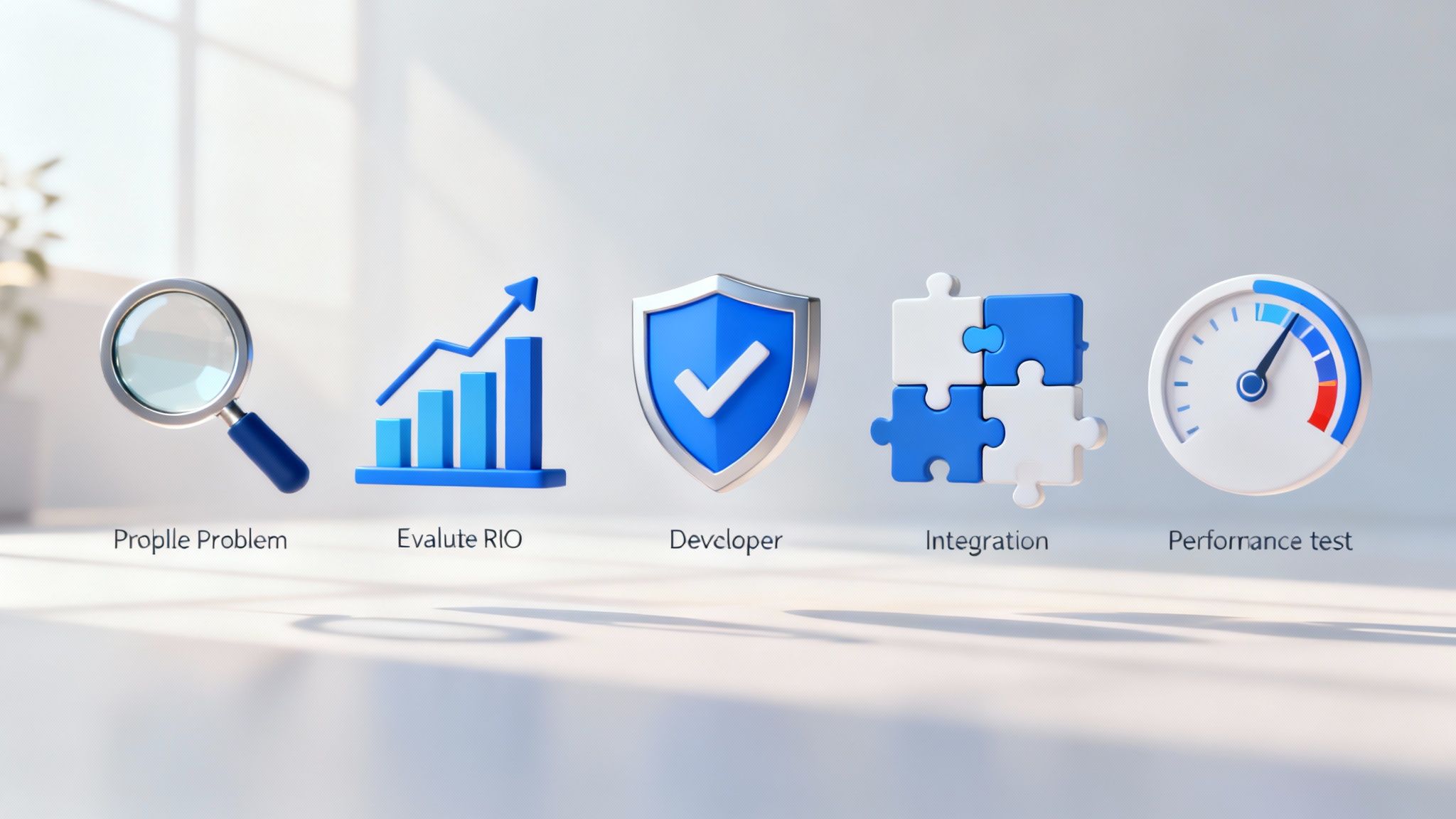
It’s all too easy to get caught up in “app collecting.” You see a cool new tool, add it, and hope that just one more feature will finally unlock more sales. But this approach almost always backfires, leaving you with a bloated, slow website that crushes your conversion rates and quietly drains your profits.
There's a much better way. Instead of hoarding apps, you need a clear framework for building a lean, powerful, and profitable tech stack. The real goal is to make sure every single app you install delivers a clear return on investment (ROI), not just another line item on your monthly invoice.
Step 1: Start With the Problem, Not the Features
This is the most critical step, and it’s the one most people skip. Don't start your journey by aimlessly browsing the app store for shiny new features. Instead, look inward and define the specific business problem you need to solve.
Start by asking questions rooted in your store’s actual performance and daily headaches.
- Problem: "My cart abandonment rate is hovering around 75%."
- Need: I need a tool that can recover those lost sales, likely through automated email or SMS reminders combined with compelling urgency.
- Problem: "Our product pages get tons of traffic, but our conversion rate is stuck below the 2.5% industry average."
- Need: I need something to build trust and urgency, like a reviews app for social proof or sophisticated marketing that leverages behavioral psychology.
When you start with a real pain point, your search for an app becomes focused and purposeful. It’s the difference between buying a tool and solving a problem.
Step 2: Calculate the Real Business Impact
Once you’ve found an app that seems to fit, the next step is to weigh its true business impact against its cost. This means focusing on ROI and revenue, not just the monthly subscription fee. Think about the potential revenue it could generate, how it could improve inventory velocity, or the hours it could save.
A great example of this is using tools for AI content optimization for e-commerce to improve your product descriptions and blog posts, which directly impacts SEO and conversions.
An app that costs $50/month but brings back an extra $1,000 in recovered carts isn't an expense—it's a high-performing investment. Framing your decision around potential ROI is how you separate the "nice-to-haves" from the "must-haves."
Step 3: Vet the Developer and Check Your Integrations
The quality of an app is a direct reflection of its developer. Before you click "install," do some digging. Read the most recent reviews, see how responsive their support team is, and check how often the app gets updated. An app that hasn't been touched in over a year is a huge red flag.
Just as important is making sure it plays well with others. Your app stack should work like a cohesive ecosystem, not a disjointed collection of tools that don’t talk to each other. Check that the app seamlessly connects with the core platforms you already rely on.
- Email & SMS: Does it integrate with Klaviyo, Postscript, or Attentive?
- Reviews & Loyalty: Will it connect to Yotpo, Judge.me, or LoyaltyLion?
- Customer Support: Can it talk to Gorgias or Zendesk?
When your tools are connected, data flows smoothly between them, unlocking powerful automation and creating a unified experience for your customers. If key integrations are missing, you’ll just end up creating more manual work for yourself, completely defeating the purpose of the app in the first place.
Apps That Tap Into Why People Buy
The best apps on a Shopify store do more than just add a new button or a fancy feature. They leverage consumer psychology to understand why people buy. This is where we move beyond simple tools and start using apps that work with behavioral economics, not against it, to drive real action. It's the difference between having a store and having a selling machine.
Many store owners make the classic mistake of slapping a basic countdown timer on their site, hoping it'll magically create a flood of sales. While timers can nudge people along, they are a blunt instrument. If not handled well, they can feel fake and damage your brand's credibility.
Real urgency marketing is much more sophisticated. It’s the science of creating genuine moments of anticipation and excitement rooted in proven psychological triggers. It enhances banners, popups, and the entire shopper journey, positioning your brand as an expert guide.
Moving Beyond Just a Ticking Clock
Advanced urgency apps don't just show a clock counting down. They build entire campaigns, or "Moments," around the core principles of behavioral economics:
- Scarcity: Grounded in the principle that humans place a higher value on things that are rare, this tactic highlights limited stock or exclusive access to trigger the desire to own something before it's gone.
- FOMO (Fear Of Missing Out): By showing that other people are buying or that a deal is about to vanish, you motivate shoppers to act now instead of putting it off, a powerful concept explored in many consumer psychology studies.
- Social Proof: Displaying how many people are looking at an item or just bought it is a powerful way to build trust. It tells a new customer, "Other people like this, so it must be a good choice," reducing purchase anxiety.
The key difference: a simple timer creates pressure. A campaign grounded in psychology creates genuine desire.
Platforms like Quikly focus on this smarter approach, using sophisticated automation and behavioral triggers to help brands generate actual revenue, not just capture a few emails like a standard popup. If you want to see how this stacks up against traditional methods, it's worth exploring the nuances of using popups on Shopify.
The Real-World ROI of Psychological Marketing
This smarter approach has a direct impact on your bottom line. With Shopify stores collectively processing over $500 billion in sales, the fight for customer attention is fiercer than ever. Apps that can speed up that journey from "just looking" to "checkout complete" are worth their weight in gold, dramatically cutting down on abandoned carts and boosting your revenue.
The goal isn't just to make a sale; it's to protect your profit margins. Sophisticated urgency allows you to sell inventory at a healthy velocity without resorting to deep, brand-damaging discounts. For a closer look at how this all translates into sales, you can explore comprehensive strategies for improving ecommerce conversion rates.
To really understand the difference in impact, let's break down how a basic timer app compares to an advanced urgency marketing platform.
Comparing Urgency App Strategies
| Feature | Basic Countdown Timer App | Advanced Urgency Marketing App (like Quikly) |
|---|---|---|
| Core Mechanic | Displays a simple, static countdown clock. | Uses dynamic, behavior-based triggers (e.g., social proof, scarcity). |
| Psychological Principle | Applies generic time pressure. | Taps into FOMO, scarcity, and social validation for genuine desire. |
| Customization | Limited; often a one-size-fits-all timer. | Highly customizable campaigns ("Moments") based on user segments and actions. |
| Brand Perception | Can feel artificial or manipulative if overused. | Creates an authentic and exciting shopping experience. |
| Business Impact | Might provide a small, temporary lift in conversions. | Drives significant, sustainable revenue growth and reduces cart abandonment. |
As you can see, the advanced approach is less about tricking customers and more about creating an engaging experience that guides them confidently toward a purchase.
When done right, urgency marketing isn't about manipulation. It’s about aligning your offers with the natural psychological drivers your customers already have. You're respecting their intelligence while creating a fun, engaging shopping experience that makes them feel good about their purchase.
This mindset protects your brand's integrity and is the key to driving sustainable growth.
And it’s not just about urgency. Personalization and loyalty apps use these same drivers. By rewarding customers for coming back and showing them you get their tastes, you can dramatically increase customer lifetime value. That's how you turn one-time buyers into lifelong fans of your brand.
Managing Your App Stack for Peak Performance
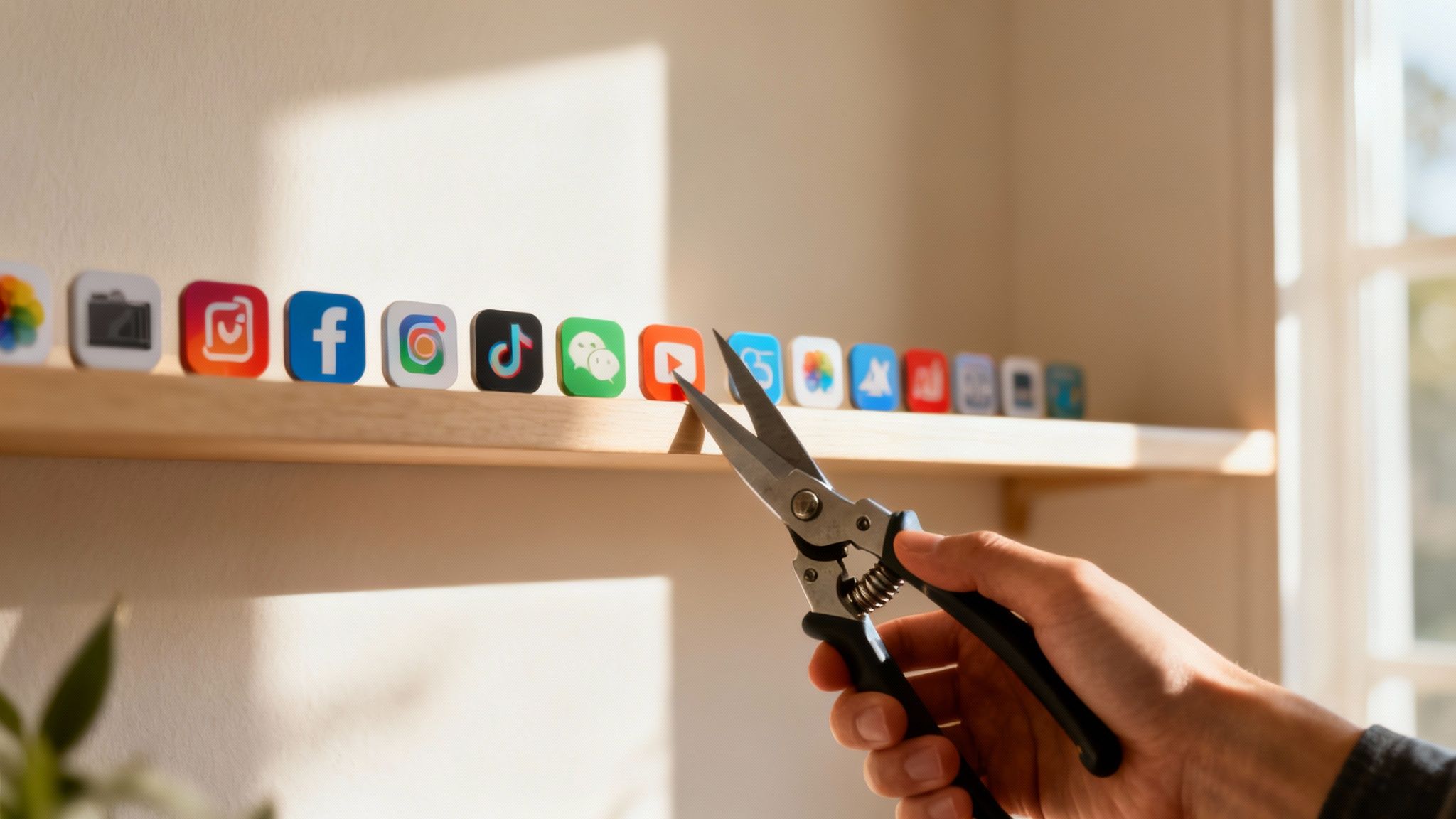
Hitting "install" on an app is really just the beginning. Your long-term success with apps for a Shopify store comes down to how well you manage your entire app ecosystem over time.
Think of it this way: a proactive approach ensures your app stack remains a strategic asset that actually drives revenue. The alternative? It becomes a technical liability that slows things down and hurts performance.
The most critical practice here is the periodic app audit. Treat it like spring cleaning for your store. Every quarter, go through each app and ask a simple, direct question: "Is this tool delivering a measurable return?"
Underperforming or unused apps don't just cost you a subscription fee. They add unnecessary code that can seriously drag down your site speed, a factor that has a direct impact on your conversion rate. Sometimes, removing just one or two slow apps can create a noticeable improvement in your store's performance.
Safeguarding Data and Ensuring Smooth Operations
Beyond pure performance, active management is absolutely crucial for security and stability. When you install an app, you’re granting it specific permissions to access your store's data, which often includes sensitive customer information.
It’s just good practice to regularly review these permissions. You want to make sure they are still appropriate for what the app does. If an app has access to data it no longer needs to function, it creates an unnecessary security risk.
Proactively managing your app stack means you’re not just a user; you’re the architect of your store’s performance. This involves regular audits, careful permission management, and leveraging integrations to create a seamless, high-performing e-commerce engine.
Creating Powerful Automated Workflows
This is where the real magic happens. The true power of a well-managed app stack comes from its integrations. When your apps can talk to each other, you can build powerful, automated workflows that save you time and increase sales.
Here’s an actionable takeaway you can implement today:
- A customer leaves a 5-star review in your reviews app (like Judge.me or Yotpo).
- This automatically triggers an event in your email platform (like Klaviyo).
- A segmented email then goes out, thanking the customer and offering them a small loyalty reward for their next purchase.
These connected systems create a seamless customer journey without you lifting a finger. To get a better sense of what's possible, you can explore some of the best marketing automation tools and see how you can connect the different pieces of your marketing strategy.
This level of integration is what turns a collection of individual apps into a cohesive, revenue-generating machine.
Your Top Shopify App Questions, Answered
If you’re wading into the world of apps for a Shopify store, you probably have a few questions. That’s a good thing. Getting clear, straightforward answers is the first step to making smarter decisions that protect your store’s performance—and your bottom line.
Let's break down some of the most common questions merchants ask, along with some practical advice to guide your thinking.
How Many Shopify Apps Is Too Many?
This is easily the most common question, and the answer is: there's no magic number. I've seen stores crumble under the weight of five bad apps and others that run beautifully with 25. The focus should always be on performance and value, not quantity. A store running a couple dozen well-coded, high-impact apps will always outperform one with a handful of slow, clunky ones.
The best habit you can build is to regularly audit your apps. Look at each one and ask a simple question: Does this directly make me money, save me time, or make my customers happier? If the answer is no, you have to question its place in your tech stack.
Always monitor your site speed after installing a new app. Stick with tools from reputable developers known for clean, efficient code. Your customers will thank you for it.
Are Free Shopify Apps as Good as Paid Ones?
Many free apps are fantastic, especially when you're just starting out or working with a tight budget. They often work on a "freemium" model, giving you solid core features for free and reserving the really powerful stuff for a paid plan. Think of them as a great entry point.
However, paid apps usually bring more to the table. We're talking more robust features, dedicated customer support who actually answer your emails, and consistent updates that keep things running smoothly, which is especially critical for Shopify Plus enterprise merchants.
When you're deciding, don't just look at the price tag. Look at the app's ability to solve your specific problem and its potential return on investment.
A $25/month app that generates $600 in extra sales every month isn't an expense. It's a wildly profitable investment.
How Can I Tell if an App Is Slowing Down My Store?
This is a critical one. Before you let a new app loose on your live store, play it safe. Use the "View in your store" feature to test it in a duplicate, unpublished version of your theme. It's like a sandbox where you can see how it behaves without risking a single sale.
After you do install an app, keep an eye on your numbers. Use tools like Google PageSpeed Insights and Shopify's built-in speed report to check for any performance hits. If you see a noticeable slowdown after adding an app—especially one that your customers interact with—it might be time to find a more lightweight alternative. Or, at the very least, get in touch with the developer's support team to see if they can help you troubleshoot.
Ready to turn those casual browsers into committed buyers? With Quikly, you can roll out smart urgency marketing campaigns built on real consumer psychology, helping you drive revenue while protecting your profit margins. Come see how our platform can give your Shopify store a serious performance boost.
Explore Quikly’s urgency marketing solutions

The Quikly Content Team brings together urgency marketing experts, consumer psychologists, and data analysts who've helped power promotional campaigns since 2012. Drawing from our platform's 70M+ consumer interactions and thousands of successful campaigns, we share evidence-based insights that help brands create promotions that convert.
